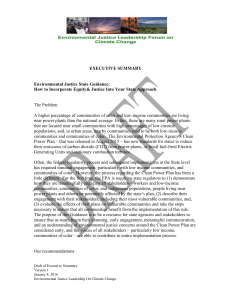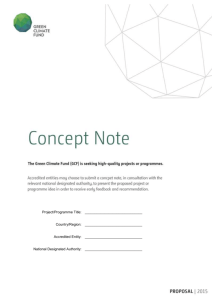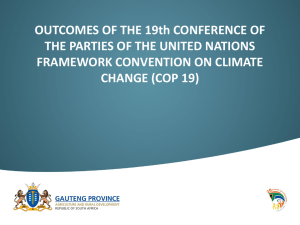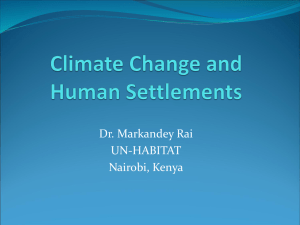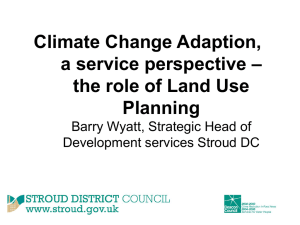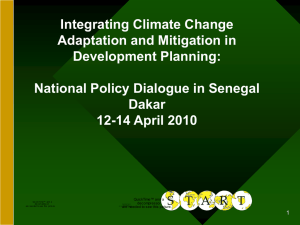Climate Change – An Indian Perspective
advertisement
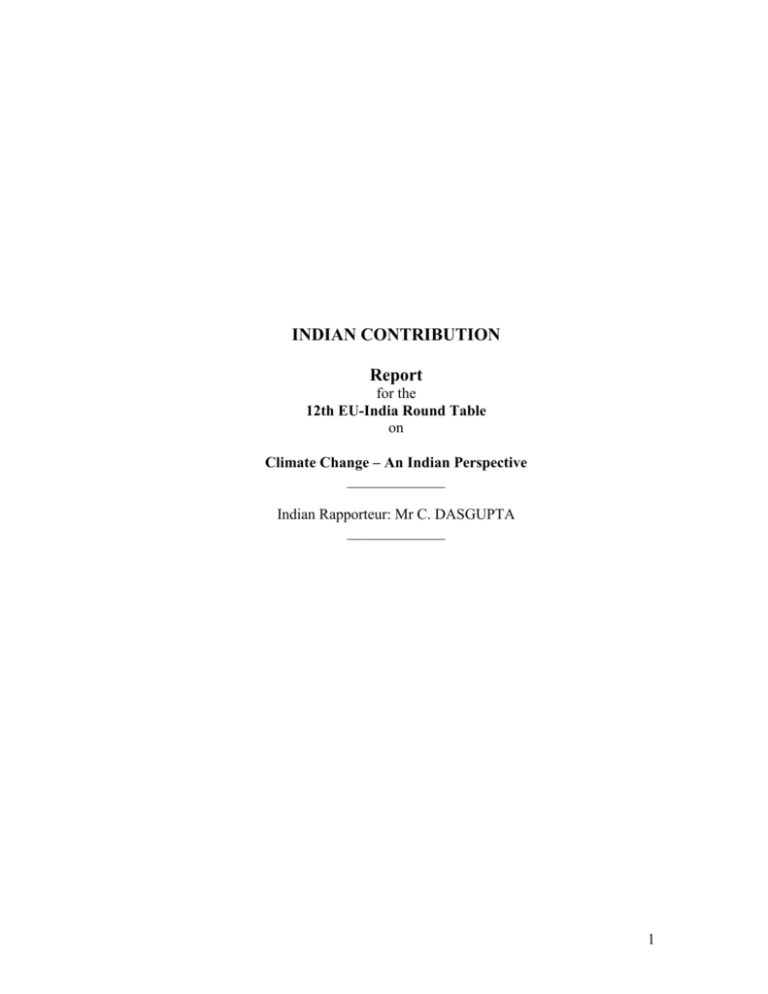
INDIAN CONTRIBUTION Report for the 12th EU-India Round Table on Climate Change – An Indian Perspective _____________ Indian Rapporteur: Mr C. DASGUPTA _____________ 1 Climate Change – An Indian Perspective Climate change is no longer a distant threat. The Fourth Assessment Report of the Intergovernmental Panel on Climate Change (IPCC), published last year, amply demonstrates that we are already experiencing climate change induced by human activities. Ever since the invention of fire, human activities have generated carbon dioxide and other greenhouse gases. However, till the advent of the Industrial Revolution, these emissions were well within the carrying capacity of the atmosphere. The Industrial Revolution, based on the combustion of hydrocarbons –initially coal, later also petroleum and natural gas – led to ever-increasing levels of emission and accumulation of carbon dioxide in the atmosphere, precipitating climate change. Historically, and even currently, the excessive levels of emission of greenhouse gases have originated in the industrialized countries. Each inhabitant of the planet has an equal right to the atmosphere. By have grossly exceeding their fair share of atmospheric resources, the industrialized countries have caused climate change. India’s per capita carbon dioxide emissions are just over 1 tonne, compared to the OECD average of over 11 tonnes. If all countries had the same per capita emission levels as India, the planet would not have faced a climate change problem. Though the responsibility for causing climate change lies with the affluent countries, its main victims will be the world’s poor. Affluent countries will be able to adapt to climate change much more successfully because they possess the requisite capital, technology and human resources. Wealthy countries can build embankments to protect coastal areas threatened by sea-level rise, construct physical infrastructure capable of withstanding extreme weather events, switch over to new seed and plant varieties better suited to cope with climate change, adopt water conservation and other necessary measures. In contrast to developing countries, the industrialized countries will not be seriously handicapped by lack of financial resources or technological know-how Last year, an article in The Economist noted that the Alps might lose their snow cover as a result of global warming, posing a threat to the ski resorts of Switzerland, the playground of the rich and famous. However, the journal was confident that the Swiss would be able to adapt successfully. It even suggested that the famous winter resorts might well be converted to cool hill stations to which Europeans might flee in summer to escape the heat of plains! 2 Low-income countries are much more vulnerable to the impacts of climate change. Last year, India had a good monsoon. It was the answer to the prayers of a billion Indians. Even so, the torrential rains and floods left thousands of people homeless and took a toll of hundreds of lives. This was not climate change; it was merely a benign seasonal change. Poverty stricken people, dwelling in flimsy huts, living in villages lacking durable infrastructure and decent communications, are unable to cope even with annual seasonal change, leave alone the sweeping transformation that may be wrought by climate change. Responding to the urgency of the challenge, Prime Minister Manmohan Singh constituted a highlevel Council on Climate Change last year. A national action plan on climate change is currently under preparation and is expected to be finalized shortly. The action plan will address both aspects of a response to climate change, namely, adaptation and mitigation. Adaptation How should a low-income country like India respond to climate change? It is obvious that we must build up our capacity to cope with climate change and adapt to its impacts. This will be possible only if we can overcome the currently severe constraints of financial, technological and human resources. The only hope lies in rapid economic and social development. Without rapid economic development, we cannot overcome the grievous lack of financial resources required for adaptation. Without rapid social development in fields such as education and public health, our workforce will be unable to adapt successfully to climate change. For a low-income country, accelerated development is the key to successful adaptation. If development slows down, future generations in our country will be grievously incapable of coping with climate change. For a lowincome country rapid development is synonymous with sustainable development. What should we do in the short-run, apart from striving to accelerate growth rates? We currently have only a broad picture of the likely impacts of climate change on India. We are not yet able to predict in detail what impacts may be expected in a specific area (say, district or sub-division). Hence, it is not feasible to design short-term strategies exclusively for climate change. Rather, we need to identify elements of our existing development plans which are likely to also enhance our capacity for adapting to climate change and to accord higher priority to these programmes. Some examples of development programmes that also promote adaptation are those related to irrigation, water conservation, flood control, coastal zone protection and disaster management. Many, if not most, development programmes have significant co-benefits for adaptation to climate change. 3 Thus, from both a short-term and long-term perspective, development itself is the best form of adaptation. Mitigation India plays her due role in international initiatives to mitigate climate change, in accordance with the provisions of the UN Framework Convention on Climate Change (UNFCCC). India’s Initial Communication to UNFCCC (2005) provides a detailed account of our response to climate change. As we saw earlier, India requires rapid and sustained development not only for poverty eradication but also for the purpose of building up her capacity to cope with, or adapt to, the impacts of climate change. The crucial question, therefore, is how to address mitigation concerns without diverting scarce resources from the primary task of economic and social development. The answer lies in proactively identifying “win-win” measures, that are primarily intended to promote development but which also yield significant co-benefits in the form of reducing greenhouse gas emissions. Such “win-win” measures fall into three general categories. 1) Cost-effective energy efficiency and energy conservation measures: These can simultaneously advance India’s development and climate change objectives. There is considerable potential for action on this front in all major areas. For example, in the power generation area, there is scope for adopting certain clean-coal technologies that satisfy the condition of cost-effectiveness. This applies also to efficient power transmission and distribution systems. In the transportation area, public transportation systems should be rapidly expanded in order to avoid undue reliance on the use of private vehicles, thereby limiting rising emissions in this sector. The use of bio-fuels should be encouraged, provided such fuels are not produced at the expense of food crops. In the industrial sector, special attention should be paid to improving energy efficiency measures wherever these do not entail major incremental costs. 2) Promotion of energy security: India’s energy security interests are served by all measures that have the effect of reducing the country’s heavy dependence on petroleum imports. Energy conservation and energy efficiency measures also serve to promote India’s energy security interests. In addition, India adopts a number of measures for diversification of energy sources from petroleum to alternative fuels and 4 sources in order to promote energy security. These include promotion of renewable energy – wind, solar and hydropower; promotion of nuclear energy; and new initiatives for harnessing domestic coal-bed methane. While these measures are primarily designed to promote energy security, they also generate important climate change co-benefits in the form of reduced carbon emissions. 3) Health-related local environmental concerns: In some cases, measures designed to address important health-related local environmental concerns can also produce important co-benefits for climate change mitigation. The decision to replace diesel by CNG as the fuel in the Delhi public transportation system is a good example. The measure was intended to address public health concerns arising from air pollution from suspended particulates. However, it also produces significant climate change co-benefits by reducing carbon emissions. Similarly, improved urban waste disposal systems result in cutting down emissions of methane – a greenhouse gas – even though their primary objective is to address public health concerns. These are measures that simultaneously promote India’s economic and social development objectives and global climate change mitigation. They are measures that India should adopt in its own national interests. It must be recognized, however, that India can only be expected to pursue measures that are cost-effective in terms of achieving its developmental objectives. Measures involving significant incremental costs can be implemented only if these additional costs are covered through international cooperation. India cannot be expected to adopt measures that would slow down its development – and thus imperil the capacity of future generations to cope with the impacts of climate change. Conclusions The major themes of this short paper may be summed up in three propositions concerning the relationship between development and climate change in India and other low-income countries: 1) In the context of climate change, rapid development is sustainable development in the case of a low-income country. If they fail to develop rapidly, low-income countries will be unable to adapt to climate change with any degree of success. Future generations in these countries will have to pay a heavy price if the present generation 5 fails to achieve rapid development. For low-income countries, development is the best form of adaptation. 2) In order to make their fair contribution to mitigating climate change, India (and other developing countries) should implement all feasible no-cost measures delivering mitigation co-benefits. They should also seek opportunities for implementing additional measures if the affluent countries meet the incremental costs. 3) It would be counter-productive for India (and other low-income countries), in terms of their economic and social progress as well as their local environmental goals, to divert scarce resources from these priorities to mitigation measures involving uncompensated incremental costs. 6
